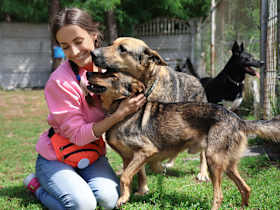10 Things You Should Know Before Getting a Rabbit
From diet to exercise needs, here’s what you need to know about caring for a rabbit.
From diet to exercise needs, here’s what you need to know about caring for a rabbit.
by Katie Koschalk, | July 8, 2024

Irina Polonina / Stocksy
Rabbits are undeniably adorable, with their twitchy noses, long ears, and cotton-ball tails. It’s easy to see why people fall in love with these charming creatures. However, caring for a bunny involves much more than just admiring their cuteness. In this article, we’ll explore 10 important things you should know before getting a rabbit. With this information, you can decide if adopting one of these floppy-eared companions is right for you.
How long do pet bunnies live? You might be surprised to learn that with proper care, a domestic rabbit can live eight to 12 years, and some even reach their teens. (Fun fact: The record for the oldest rabbit ever belongs to an Australian bunny who lived for 18 years.) This lifespan means that adopting a rabbit is a long-term commitment, and comparable to caring for a cat or dog.
Many people picture rabbits living in a garden or backyard hutch, but Heather Bechtel, director at The Rabbit Haven, recommends keeping pet rabbits indoors. Not only is it safer, but they actually prefer it. “They are social animals,” she says, “and may become listless and depressed if housed by themselves and isolated from the family.”
Rabbits who are well-behaved and litter-box trained can free-roam your house, as long as the space is bunny-proofed (see below for what bunny-proofing entails). Rabbits who are untrained or extra mischievous can be kept in a large exercise pen (at least four by six feet) when you’re unable to supervise them.
Rabbits are active, playful animals who need plenty of space to exercise. They should have at least two to four hours outside of their enclosure to play, hop around, and explore. If you don’t want them to have access to your whole house, you can use baby gates to prevent access to certain areas.
Just like cats and dogs, rabbits need mental stimulation and enjoy playing with toys. They have an instinct to chew, dig, and explore, so choose toys that cater to these behaviors. Some popular options include bunny-safe chew toys, cardboard tunnels, digging boxes filled with shredded paper, and puzzle feeders.
In addition to loving human companionship, rabbits thrive in the company of other rabbits. They live in large groups in the wild, so they’re accustomed to social living. Consider adopting two rabbits to keep each other company, especially if you’re not home for hours at a time. This companionship prevents loneliness and helps your rabbit feel more content in their home.
Contrary to popular belief, rabbits don’t live on carrots. “Carrots, though pictured with rabbit-cartoon characters, are high in sugar and are given as a treat — just small pieces,” says Bechtel.
In reality, high-quality hay makes up 80 to 90 percent of a bunny’s diet. Good types of hay for rabbits include timothy, orchard grass, and oat hay. Each day, adult rabbits also eat about two cups of fresh, leafy greens, such as romaine lettuce, parsley, kale, and cilantro, says Bechtel. Fruit, other vegetables, pellets, and rabbit treats can be given in moderation. Fresh water should also always be available.
Rabbits are intelligent animals and can learn new things exceptionally well with positive-reinforcement training. You can train your bunny to use a litter box, come when called, and even perform simple tricks like turning in a circle. Training sessions should be kept short (about three to five minutes long). If your bunny shows any sign of stress, such as wanting to move away or freezing up, stop immediately and give them space.
Like other pets, rabbits require regular veterinary check-ups and care to maintain their health. Bechtel says rabbits need a yearly vaccine for viral hemorrhagic disease (VHD) and may also need flea control if you have other indoor-outdoor animals. Plan to find an exotics vet and schedule a checkup annually.
Rabbits are known for their affectionate nature and can form strong bonds with their human companions. However, it’s important to understand that while some rabbits might enjoy being held or carried, most do not and may become stressed by these actions.
To build a trusting relationship, spend time sitting on the floor with your bunny, allowing them to approach and interact with you on their terms. Gentle petting and offering treats can help create positive associations with your presence. A favorite petting spot for most rabbits is the area between the ears.
While rabbits don’t ever need baths, they do require brushing, especially if they’re long-haired. Brushing prevents matting and reduces the amount of loose fur they swallow due to grooming. This is important because, unlike cats, rabbits can’t throw up hairballs. You’ll also need to trim their nails every six to eight weeks.
Rabbits can be wonderful companions, but if you’re unsure whether a rabbit is the right pet for you, consider fostering one first. This allows you to experience firsthand what caring for a rabbit involves and help a rabbit in need.
If you’ve considered the responsibilities and decided you’re ready, here are some steps to ensure a smooth transition for everyone when bringing your new bunny home.
Rabbits require plenty of care and attention. Be prepared for tasks such as feeding, cleaning their living space and litter box, providing mental stimulation, supervising their exercise/play time, and simply offering company and companionship.
Emergencies can happen, so it’s crucial to have a plan. Identify a rabbit-savvy veterinarian, and know where the nearest emergency animal clinic is located.
Adopting a rabbit should be a household decision. Discuss the responsibilities and care requirements with everyone in the family to ensure everyone is on board and willing to contribute to the rabbit’s well-being.
Bunnies can get along with cats and dogs, but it’s vital to gradually introduce them. Start by feeding them on opposite sides of a barrier. Next, allow them to sniff each other through a barrier. Once all pets can do these things calmly, supervise short interactions until you’re confident they can coexist peacefully.
Word of caution: Rabbits are prey animals, so if you have a dog with strong prey instincts, it may not be safe to add a rabbit to your family. If you have a more docile dog, it's still important to be cautious and aware of your dog’s behavior around your rabbit.
According to Amy Pratt, founder of The Bunny Lady, most rabbits cost $35 to $50 if adopted from a shelter. You should also expect to spend $300 on the initial supplies, and if your bunny doesn’t come spayed/neutered, another $300 on the surgery. Ongoing costs are around $150 per month.
Be sure you can handle unexpected veterinary bills, too. Signing up for pet insurance can help with those unforeseen expenses. At the time of publishing this story, Nationwide is the only company that offers comprehensive pet insurance for rabbits.
If you’re renting your living space, make sure your lease allows pets (and specifically rabbits). Some landlords may have restrictions or require a pet deposit. It’s important to confirm these details before bringing a rabbit home.
Rabbits are curious and love to chew, so it’s essential to bunny-proof your home to keep them safe. This entails:
Covering electrical cords (they love to chew these)
Removing toxic plants and foods
Blocking off restricted areas and small spaces where they could get stuck
Securing furniture and décor
Rabbits are more delicate and fragile than other pets and don’t often tolerate being held and carried. They may respond to being carried or held by struggling or scratching, which puts both the rabbit and (if you have one) child at risk of getting hurt. It’s crucial to teach children how to handle the rabbit gently and respectfully. Supervise their interactions until you’re confident they can handle a bunny with care.
Bunnies aren’t as low-maintenance as you’d think. They require a varied diet, regular exercise, social interaction, playtime, companionship, and routine vet checkups. Consider these responsibilities before adopting a rabbit.
Technically, pet rabbits can live outdoors in a hutch with the right considerations for safety and comfort. However, it’s recommended that they be kept indoors. They much prefer it due to their social nature, and it’s safer and more comfortable.
No, rabbits do not hibernate. They remain active year-round.
You can adopt a bunny from animal shelters, rescue groups, or rabbit-specific organizations. Adoption not only gives a rabbit a second chance, but reduces shelter overcrowding and supports animal welfare efforts.
Ready to adopt a bunny? Use Adopt a Pet’s search feature to search for rabbits from shelters, rescues, and individuals.

Katie Koschalk is a freelance writer based in Northern California. Fusing her love and knowledge of animals with her journalism degree and years of professional writing, Katie is dedicated to improving the lives of pets and their caretakers by sharing helpful and accurate information. When she’s not at her desk, you can find her exploring trails with her Aussie, Hunter, cooking plant-based meals, and talking to her two cats, Jax and Sadie, in really ridiculous voices.

Foster & Volunteer

Adoption Advice

Adoption Advice

Adoption Advice
Yes, there is a difference. Read on for everything you’ll ever need to know to distinguish one from the other.

Adoption Advice
These giant guinea pigs are smart and social, so what could go wrong? Read on to better understand why these animals don’t make good pets, and why they’re outlawed in several places.

Adoption Advice
Wondering about tax savings for pet expenses? Learn about pet tax deductions to understand how to claim your pet on taxes.

Adoption Advice
Is the responsibility of taking care of your pet causing you to worry about your budget? Rest assured, there are a number of ways to minimize this financial stress.

Shelters & Rescue
When you adopt from these rescues, you help an animal and the planet, too.

Shelters & Rescue
Debunk a few animal shelter myths and learn the benefits of adopting from a shelter or rescue group.